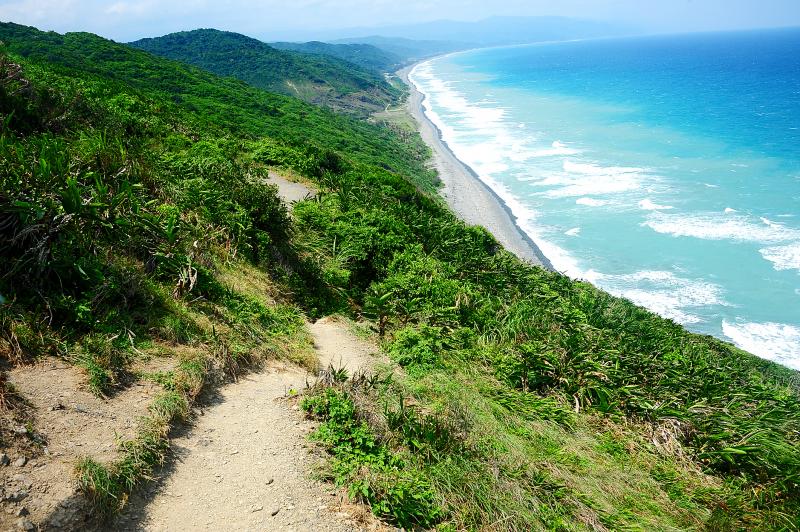A man surnamed Hou last year accomplished the impressive feat of walking all the way around Taiwan — a distance of 1,300km — in 35 days. However, on reaching home safe and sound, Hou discovered that he had been served a NT$30,000 fine for entering the historic Alangyi Trail within Pingtung County’s Syuhai Guanyin Cape Nature Reserve without a permit. Hou took issue with the fine, which was administered by Pingtung County Government, arguing that the signage in the area was unclear, causing him to accidentally stray onto the off-limits trail. Hou launched an appeal to have the fine withdrawn, but Pingtung District Court ruled against Hou.
Hou said he struck out on a clockwise walking tour of Taiwan at the end of February last year. He said that on March 28 he was continuing southward along the established coastal path after leaving Nantian Village in Taitung County’s Daren Township. Hou said the weather was overcast with drizzle and he did not see any signage that prohibited use of the path. He added that there were no gates or other paraphernalia that signified restricted access.
Hou said he suddenly encountered someone who identified themselves as working for the nature reserve and asked Hou to show his ID. Hou said he cooperated throughout the process and told the worker he was unaware that he had to apply in advance to enter the nature reserve, but that on returning home he discovered that he had been fined NT$30,000 by Pingtung County Government.

Photo: Tsai Tsung-hsien, Liberty Times 照片:自由時報記者蔡宗憲
Pingtung County Government said that the Syuhai Guanyin Cape was designated as a nature reserve in 2012 and over 45,000 people apply for an entry permit every year; furthermore the media frequently report on the area, making it one of the best-known scenic spots in the country. A spokesperson for the government added that there is obvious signage in addition to guard posts installed at the entrances to both ends of the only trail within the reserve, but Hou had ignored the signs and trespassed into the area, paying no heed to the warnings. The spokesperson added that the government issued a fine for a breach of the Cultural Heritage Preservation Act, which allows for a fine of between NT$30,000 and NT$150,000, and that the minimum fine of NT$30,000 was imposed in this instance because Hou was a first-time offender.
(Liberty Times, translated by Edward Jones)
去年侯姓男子徒步三十五天完成環台一周一千三百公里壯舉,平安回到家後卻收到一張三萬元罰單,原因是未經申請闖入被列為「旭海觀音鼻自然保留區」的阿朗壹古道,遭屏東縣政府開罰,侯男不服,認為標示不清,他非故意闖入,遂提告請求撤銷處分,屏東地院判他敗訴。
侯男主張,他去年二月底採順時鐘方向展開徒步環台行程,於三月二十八日從台東縣達仁鄉南田村沿海岸邊既成道路續往南行,途中陰雨濛濛未見任何禁止告示或相關阻絕設施,突遇自稱保留區管制人員要求他出示證件,他全程配合,並表示不知道進入保留區須事先申請,但還是被屏東縣政府開罰三萬元。
屏東縣政府主張,屏縣府二O一二年公告指定旭海觀音鼻自然保留區,每年有超過四萬五千人次申請進入,經媒體頻繁報導,為全國知名景點,縣府並於區內唯一步道兩端入口處設置明顯告示牌及崗哨,但侯男卻漠視擅闖並對解說員提醒置若罔聞,縣府才依違反文資法處三萬元以上十五萬元以下罰款,念其為初犯,以最低金額三萬元開罰。
(自由時報記者李立法)

Historians are rethinking the way the Holocaust is being presented in museums as the world marks the 80th anniversary of the liberation of the last Nazi concentration camps this month. Shocking images of the mass killings of Jews were “used massively at the end of World War II to show the violence of the Nazis,” historian Tal Bruttmann, a specialist on the Holocaust, told AFP. But in doing so “we kind of lost sight of the fact that is not normal to show” such graphic scenes of mass murder, of people being humiliated and dehumanized, he said. Up to this

A ‘Dutch angle’ is a classic camera technique that has been used in filmmaking since the 1920s, when it was introduced to Hollywood by German Expressionists. Why is it called the Dutch angle if it’s actually German? In fact, it has no __1__ to the Netherlands. The term “Dutch” is widely believed to be a misinterpretation of “Deutsch,” which means German in the German language. In any event, the name stuck, and the Dutch angle remains a popular cinematic tool to this day. This technique involves tilting the camera on its x-axis, skewing the shot to create a sense of

When people listen to music today, they typically use streaming services like YouTube or Spotify. However, traditional formats like vinyl records have regained popularity in recent times. Vinyl records are circular discs that store music in grooves on their surfaces and are played on a turntable. As the turntable’s needle runs along these grooves, it picks up vibrations and translates them into sound. The history of vinyl records dates back to the late 1800s, but material and technological challenges delayed mass production until the 1950s. Despite early versions having short playtimes and poor sound quality, vinyl records introduced a new era

Dos & Don’ts — 想想看,這句話英語該怎麼說? 1. 能做的事都做了。 ˇ All that could be done has been done. χ All that could be done have been done. 註︰all 指事情或抽象概念時當作單數。例如: All is well that ends well. (結果好就是好。) All is over with him. (他已經沒希望了。) That’s all for today. (今天到此為止。) all 指人時應當作複數。例如: All of us are interested in his proposal. All of us are doing our best. 2. 我們這麼做有益於我們的健康。 ˇ What we are doing is good for our health. χ What we are doing are good for our health. 註︰以關係代名詞 what 引導的作為主詞的子句,動詞用單數。如: What he said is true. 3. 大家都沿著步道跑。 ˇ Everybody runs along the trail. χ Everybody run along the trail. 註︰everyone 是指一大群人,但在文法上一般用單數。 4. 桌上有一本筆記本和兩支筆。 ˇ There were two